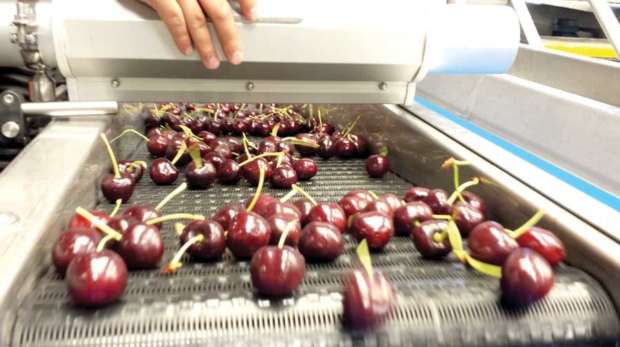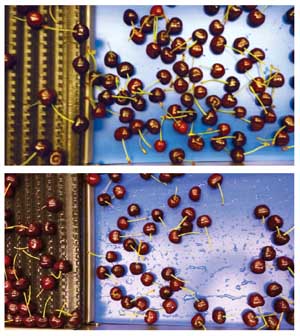
In trials, using air knives to apply pressurized air to the cherries in the final section of the packing line helped reduce the moisture getting into packages with the fruit. (Courtesy Washington State University)
Scientists at Washington State University are testing a three-prong approach to reducing splitting of fresh cherries during storage, which can be a significant problem for the industry.
Packaged cherries absorb moisture during storage. As the cherries go through physiological changes and the pressure inside the fruit increases, the skin becomes thinner and the fruit tends to crack.
Dr. Girish Ganjyal, food processing specialist at WSU, is leading a project to address the problem with these techniques:
—Applying edible coatings that serve as a barrier to prevent the cherries from absorbing moisture.
—Removing excess surface moisture from the cherries on the packing line.
—Packing cherries in desiccant-embedded polyethylene bags to absorb excess moisture inside.
Initial trials were conducted in 2014 at WSU’s Pullman campus, and in 2015 three trials were conducted in packing houses.
Ganjyal and his colleagues found that using air knives to apply pressurized air to the cherries in the final section of the packing line reduced the amount of moisture going into the packages with the cherries.
The type of drain belt had a significant effect on the amount of moisture removed. Drain belts with bigger holes worked best.
Lab studies, using a scanning electron microscope, showed that cherries have an uneven surface and excess moisture can pool in pores.
The scientists decided to test whether an edible coating could smooth out the surface to reduce the amount of water that accumulates on the surface and is then absorbed by the cherry.
In the lab, the scientists screened 16 edible coatings and tested the four most promising in a packing plant. Cherry varieties used for the tests were Chelan, Skeena and Sweetheart.

Top: A packing line with an air knife installed. Bottom: A packing line without an air knife. Notice the water droplets below. (Courtesy Washington State University)
The coatings were dissolved in warm water, then cooled to room temperature before application. They were applied to the cherries either by dipping the fruit in the coating solution or by running the cherries under a waterfall applicator. Both methods worked well.
The cherries were held in cold storage at WSU for four to six weeks at a temperature of 40 to 41 degrees Fahrenheit and 86 percent relative humidity.
Gum acacia (gum Arabic) proved to be the best coating in terms of reducing fruit splitting. An added benefit was that the cherry stems stayed green longer than those of non-coated fruit.
Packaging with a desiccant and with holes decreased the amount of moisture inside and reduced cherry cracking during storage.
No significant differences were noticed in color, firmness, percentage Brix, or pH level of coated cherries versus untreated cherries, but the coatings appeared to reduce firmness loss in storage.
Though air drying alone reduced cracking, the coating reduced it even further and also reduced the stem browning, Ganjyal reported. This suggests that the coating seals the stems and reduces moisture loss.
In trials last season at three packing houses, air drying and the gum Arabic coating again reduced cracking during six weeks of storage. However, use of desiccant bags did not consistently reduce cracking.
Ganjyal is proposing to continue the work for three years in order to develop specific strategies for reducing cherry splitting. He plans to:
—Identify how the gum acacia film reduces cracking and explore the science behind it.
—Explore ways to enhance the strength and film-forming ability of the coating by using a superior grade of gum acacia and by adding other edible coatings and modifiers, such as agar or sodium alginate.
—Study the ability of enhanced coatings to reduce stem browning. Typically, after cherries are packed, they are cooled in super cooling tunnels with forced air that flows across the packed fruit, which is believed to dry out the stems.
—Optimize the amount of desiccant incorporated into the packaging and the number of holes punched in the bag to maintain the appropriate level of relative humidity inside the bag during storage.
In the final year, Dr. Carolyn Ross will test consumer acceptance of coated cherries at the sensory laboratory in WSU’s School of Food Science.
Also collaborating in the project are Dr. Shyam Sablani, biological systems engineer at WSU, and Dr. Yan Wang, postharvest physiologist at Oregon State University.
The Washington Tree Fruit Research Commission has provided funding. •
– by Geraldine Warner






Leave A Comment